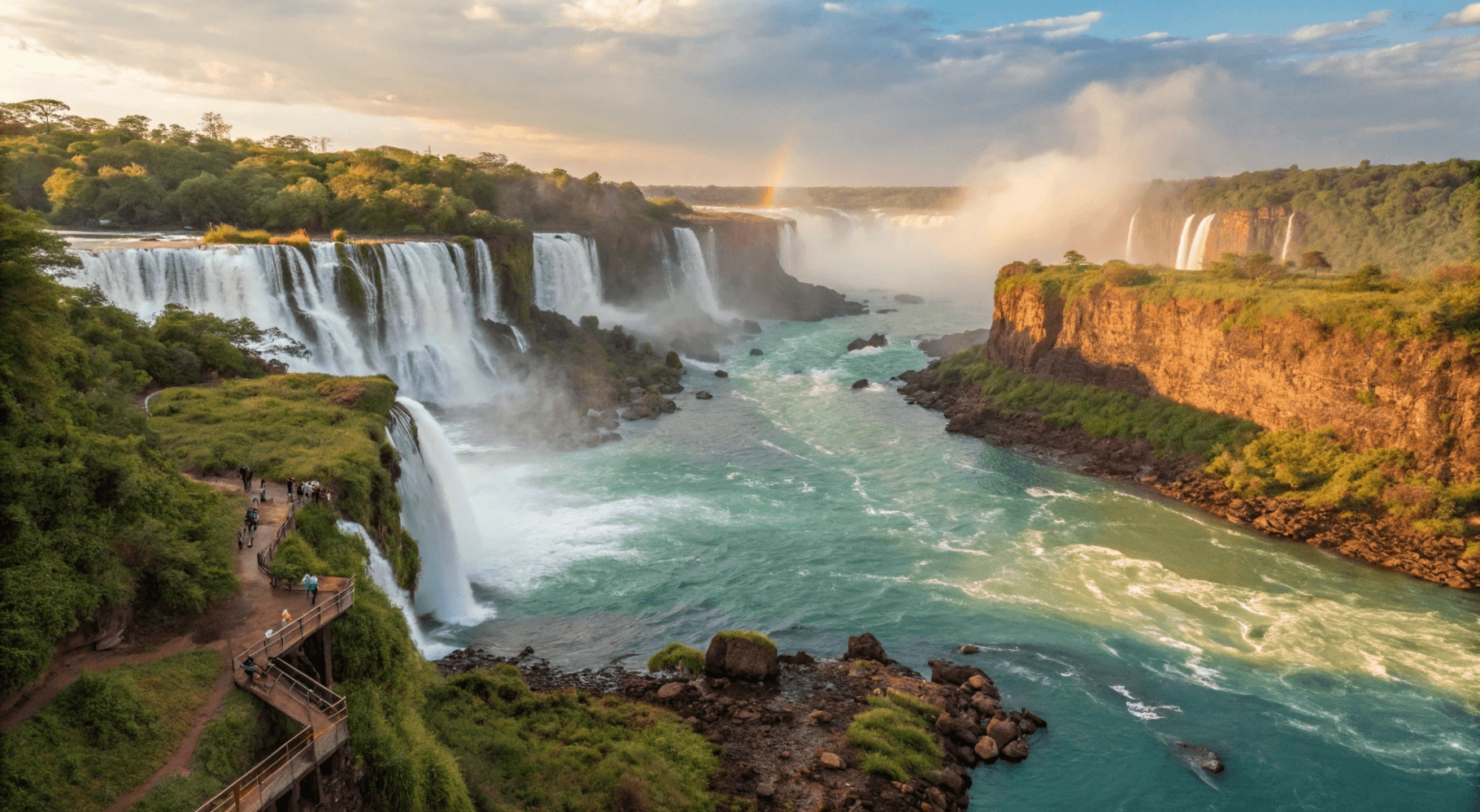Searching for “large waterfalls nyt”? You’re likely looking for either the NYT crossword answer or articles from the New York Times about stunning waterfalls. You’ve come to the right place! This comprehensive guide covers both the common crossword answers and dives into notable large waterfalls, including those featured or discussed by the NYT. Whether you’re stuck on a puzzle clue or planning your next adventure to witness nature’s power, this is the most comprehensive resource available.
Table of Contents
NYT Crossword Clue Answer: Large waterfalls
The most common answers for the NYT crossword clue “Large waterfalls” are CATARACTS or CASCADES.
When you encounter this clue in your New York Times puzzle, you’ll typically need to fill in one of these answers depending on the number of squares and intersecting words. “Cataracts” refers to large, powerful waterfalls with tremendous volume and force. The term comes from the Greek word “kataraktes,” meaning “down-rushing.” Meanwhile, “Cascades” describes a series of smaller falls in succession, though crossword constructors sometimes use it interchangeably with larger waterfalls.
CATARACTS is often the intended 9-letter answer, while CASCADES (8 letters) appears when space constraints differ. This type of nature-based clue recurs regularly in the NYT puzzle, especially in themed puzzles celebrating natural wonders or geographic features. “large waterfalls nyt”
Waterfalls in the New York Times: From Travel Features to News
The New York Times is renowned for its exceptional travel section and environmental reporting, which frequently cover significant natural wonders, including the world’s most impressive waterfalls. The newspaper’s coverage provides unique perspectives on these natural phenomena, combining literary description with practical travel advice.
The NYT has highlighted the renewed power of Yosemite Falls after periods of heavy rainfall, documenting how climate patterns affect these natural wonders. Their travel writers have ventured to remote locations like Angel Falls in Venezuela, providing readers with virtual journeys to places many will never see in person. Angel Falls is also profiled in-depth by the Encyclopaedia Britannica, offering a detailed look at its discovery, geography, and hydrology. The paper’s environmental reporting often examines conservation efforts around famous waterfalls, including the delicate balance between tourism and preservation at sites like Niagara Falls. The U.S. National Park Service provides a comprehensive resource on Niagara Falls, including historical context, visitor information, and conservation initiatives. “large waterfalls nyt”
Analysis of the NYT’s waterfall coverage reveals several consistent themes:
- Focus on accessibility and seasonal timing for optimal viewing experiences
- Environmental concerns including water flow changes due to climate shifts
- Historical and cultural significance of waterfalls to indigenous peoples
- Photography tips for capturing these dynamic natural features
It’s quite possible that crossword clues like “Large waterfalls” are inspired by features on giants like Victoria Falls or Iguazu Falls, which appear periodically in the paper’s travel section. The NYT’s comprehensive coverage of these natural spectacles serves as inspiration not just for puzzle creators but for travelers seeking to experience the raw power of rushing water. “large waterfalls nyt”
Exploring the World’s Most Famous Large Waterfalls
Niagara Falls: North America’s Powerhouse
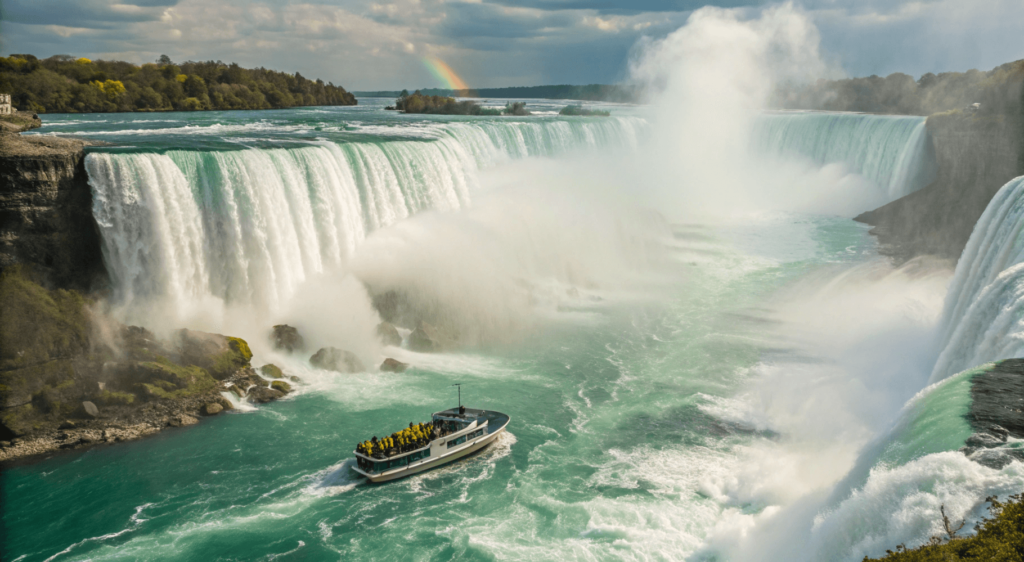
Location: Border of New York, USA and Ontario, Canada
Height: 167 feet (51 meters)
Width: 3,950 feet (1,204 meters)
Flow Rate: 85,000 cubic feet (2,400 cubic meters) per second
Niagara Falls stands as one of the most recognized waterfalls globally, comprising three distinct falls: Horseshoe Falls, American Falls, and Bridal Veil Falls. What makes Niagara spectacular isn’t its height but rather its impressive width and the sheer volume of water cascading over its edge. The thunderous roar and constant mist create an immersive sensory experience.
The New York Times has covered Niagara extensively, from historical pieces about daredevils who’ve attempted to navigate the falls to environmental reports on conservation efforts. Interestingly, Niagara Falls temporarily stopped flowing in 1848 when ice blocked the water supply from Lake Erie. More geological and historical context on Niagara Falls can be found via the U.S. Geological Survey (USGS), which documents changes in flow, erosion, and ecological impact. “large waterfalls nyt”
Victoria Falls: The Smoke That Thunders
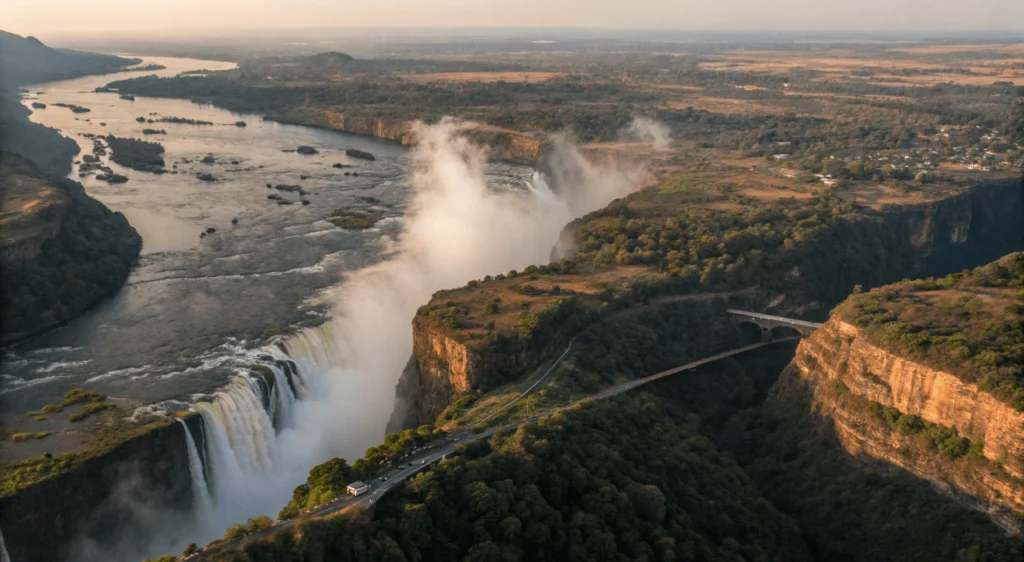
Location: Border of Zambia and Zimbabwe
Height: 355 feet (108 meters)
Width: 5,604 feet (1,708 meters)
Flow Rate: 38,430 cubic feet (1,088 cubic meters) per second during peak season
Known locally as “Mosi-oa-Tunya” or “The Smoke That Thunders,” Victoria Falls creates the world’s largest sheet of falling water when the Zambezi River is at high flow. The spray from the falls can be seen from up to 30 miles (48km) away, creating a permanent cloud above the waterfall that gives it its evocative nickname. “large waterfalls nyt”
The NYT travel section has featured Victoria Falls numerous times, highlighting both the natural wonder itself and the changing tourism landscape in Zimbabwe and Zambia. The falls represent one of Africa’s most significant natural attractions and were designated a UNESCO World Heritage Site in 1989. Details about this designation and conservation status are available on the UNESCO World Heritage Centre’s page for Victoria Falls.
Angel Falls: The World’s Tallest
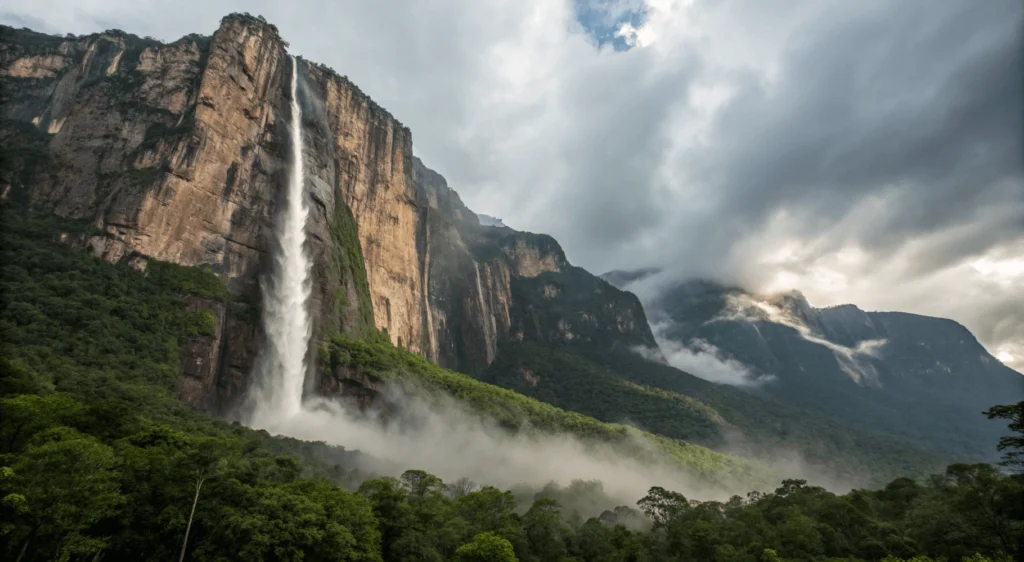
Location: Canaima National Park, Venezuela
Height: 3,212 feet (979 meters)
Width: 500 feet (150 meters) at its base
Flow Rate: Varies dramatically by season
Angel Falls stands as the world’s highest uninterrupted waterfall, with water plummeting from the edge of Auyán-tepui mountain. Named after American aviator Jimmy Angel who flew over the falls in 1933, this remote wonder requires significant effort to visit, typically involving flights to Canaima followed by river boat journeys and hiking.
The New York Times has documented the challenges of reaching Angel Falls and the decreasing water flow during dry seasons. The newspaper has also covered the indigenous Pemon people’s relationship with the falls, whom they call “Kerepakupai Merú” or “waterfall of the deepest place.” For an ecological and cultural overview, see Canaima National Park’s profile on UNESCO, which includes Angel Falls and highlights the area’s biodiversity and indigenous significance. “large waterfalls nyt”
Iguazu Falls: A System of Spectacular Cascades
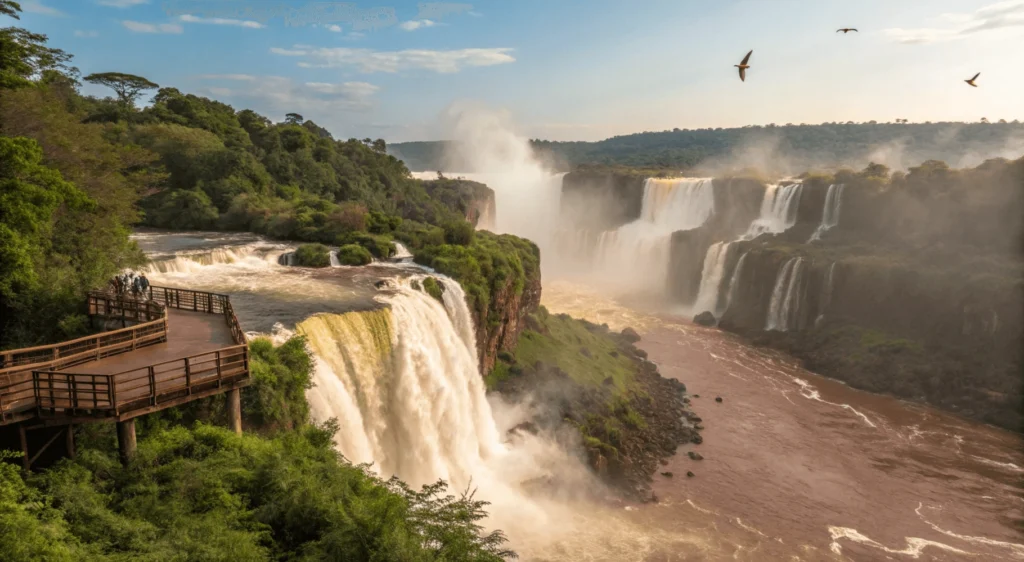
Location: Border of Argentina and Brazil
Height: 269 feet (82 meters)
Width: 8,858 feet (2,700 meters)
Flow Rate: 61,660 cubic feet (1,746 cubic meters) per second
Iguazu Falls consists of 275 individual drops spanning nearly 2 miles across the border of Argentina and Brazil. What makes Iguazu unique is its horseshoe configuration called “Devil’s Throat,” where water converges from multiple directions into a dramatic U-shaped chasm.
NYT travel writers have praised the exceptional viewing platforms available on both the Brazilian and Argentine sides, offering visitors dramatically different perspectives. The surrounding subtropical rainforest hosts incredible biodiversity, including over 2,000 plant species and wildlife like toucans, giant anteaters, and jaguars. Additional information is available from the Iguazú National Park (Argentina) official site, which includes conservation efforts, trail maps, and viewing tips.
Yosemite Falls: America’s Tallest
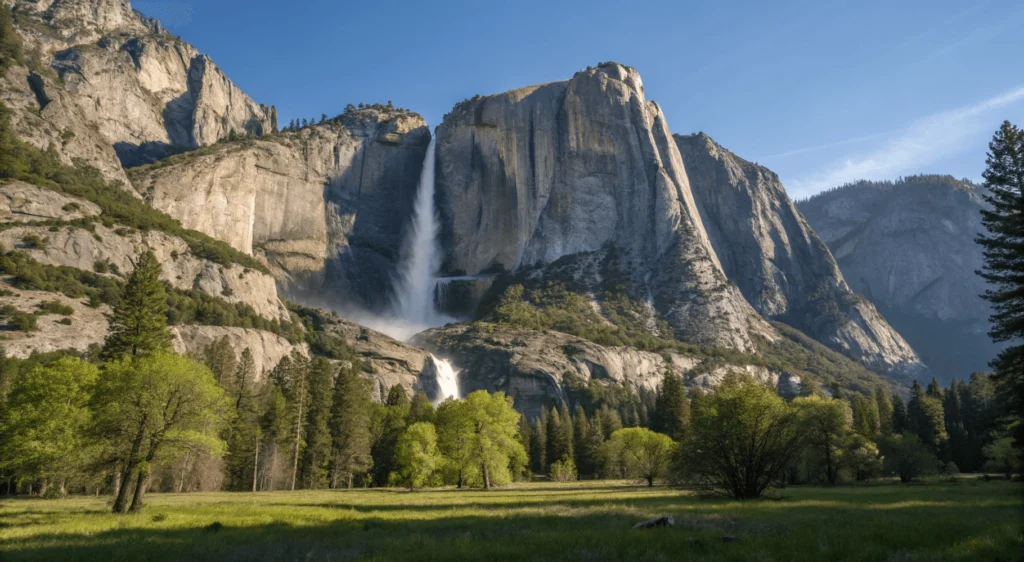
Location: Yosemite National Park, California, USA
Height: 2,425 feet (739 meters) in three sections
Width: Varies by section
Flow Rate: Highly seasonal, peaking in late spring
Yosemite Falls consists of three sections: Upper Yosemite Fall (1,430 feet), the middle cascades (675 feet), and Lower Yosemite Fall (320 feet). The falls are most impressive during spring when snowmelt from the Sierra Nevada mountains feeds the Yosemite Creek. By late summer, the falls often dry to a trickle or stop completely. “large waterfalls nyt”
The New York Times regularly reports on changing conditions at Yosemite Falls, particularly in relation to California’s drought cycles and climate change impacts. The newspaper has documented how varying precipitation patterns have created boom-and-bust cycles for this iconic waterfall, sometimes returning to thunderous glory after years of reduced flow. The National Park Service’s Yosemite Falls page provides real-time updates, seasonal flow charts, and tips for witnessing the falls at their peak. “large waterfalls nyt”
What’s the Difference? Cataracts, Cascades, and Waterfalls
Understanding waterfall terminology helps appreciate both their natural formation and their appearances in contexts like crossword puzzles: “large waterfalls nyt”
| Term | Definition | Example |
|---|---|---|
| Waterfall | General term for water flowing over a vertical drop | Any vertical water flow |
| Cataract | Large, powerful waterfall with enormous volume | Niagara Falls |
| Cascade | Series of small falls in quick succession | Lower portions of Yosemite Falls |
| Plunge | Water that loses contact with the rock face | Angel Falls |
| Horsetail | Water maintaining contact with rock while falling | Lower Yosemite Falls |
| Tiered | Multiple distinct drops in succession | Gullfoss in Iceland |
Cataracts specifically refer to waterfalls with tremendous water volume and force. The term derives from medical cataracts (clouding of the eye lens) because both share a whitish, cloudy appearance. In historical literature, “cataract” often described any large, powerful waterfall before modern classification systems developed. “large waterfalls nyt”
Cascades, by contrast, typically involve water flowing over a series of rock steps rather than a single dramatic plunge. The Rocky Mountains’ Cascade Range takes its name from the many waterfalls found throughout the mountain system. While technically different, both terms appear as answers to “large waterfalls” in the NYT crossword, depending on available letter spaces. “large waterfalls nyt”

How Waterfalls Are Classified as “Large”
What makes a waterfall “large” depends on several metrics: “large waterfalls nyt”
- Height: The vertical distance water falls (Angel Falls ranks first)
- Width: The horizontal span across the crest (Khone Falls in Laos spans nearly 35,376 feet)
- Volume: The amount of water flowing over the edge (Amazon’s Guaíra Falls, now submerged by a dam, once had the largest volume)
- Overall Scale: A combination of height, width, and volume (Iguazu and Victoria Falls often considered the most impressive overall) “large waterfalls nyt”
“A waterfall’s size is less a single measurement than a combination of factors that together create its dramatic impact on observers.” — Hydrologist statement cited in a 2022 NYT environmental feature “large waterfalls nyt”
Seasonal Considerations for Viewing Large Waterfalls
The New York Times travel guides frequently emphasize timing when visiting major waterfalls:
- Spring: Optimal for northern hemisphere falls like Yosemite when snowmelt maximizes flow
- Rainy Season: Best for tropical falls like Angel Falls and Victoria Falls
- Winter: Some falls like Gullfoss in Iceland take on dramatic frozen formations
- Drought Periods: Can dramatically reduce even mighty falls to disappointing trickles
Conservation Challenges Facing Major Waterfalls
The NYT’s environmental reporting regularly addresses threats to the world’s great waterfalls:
- Climate Change: Altering precipitation patterns and reducing glacial sources
- Hydroelectric Development: Damming rivers that feed falls (like the now-submerged Guaíra Falls)
- Tourism Impact: Erosion from foot traffic and infrastructure development
- Water Diversion: Agricultural and urban use reducing water flow “large waterfalls nyt”
Conservation organizations worldwide work to protect these natural wonders through UNESCO designations, national park status, and international river basin agreements. “large waterfalls nyt”
Conclusion: The Timeless Appeal of Magnificent Waterfalls
Whether you came looking for a crossword answer (CATARACTS or CASCADES) or seeking inspiration for your next natural wonder to visit, large waterfalls remain among Earth’s most awe-inspiring features. From the NYT puzzle page to the newspaper’s vivid travel features, these powerful formations capture imagination and draw travelers from across the globe.
The next time you encounter “large waterfalls” in your NYT crossword, you’ll not only know the likely answers but understand the magnificent natural phenomena behind the clue. Each of these waterfalls tells a story of geological forces, environmental change, and human wonder that transcends simple puzzle solutions. “large waterfalls nyt”
Did this help with your crossword? Which large waterfall fascinates you most? Let us know in the comments!
Related Articles: “large waterfalls nyt”
- Exploring National Parks: America’s Natural Treasures
- Crossword Tips: Mastering Nature Clues
- Seasonal Travel Guide: When to Visit Natural Wonders

